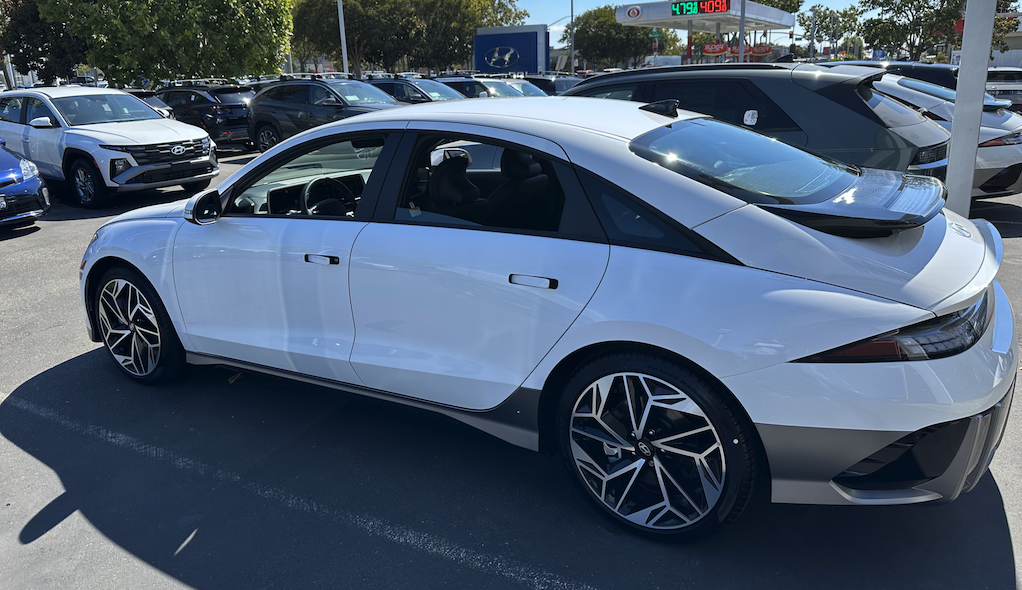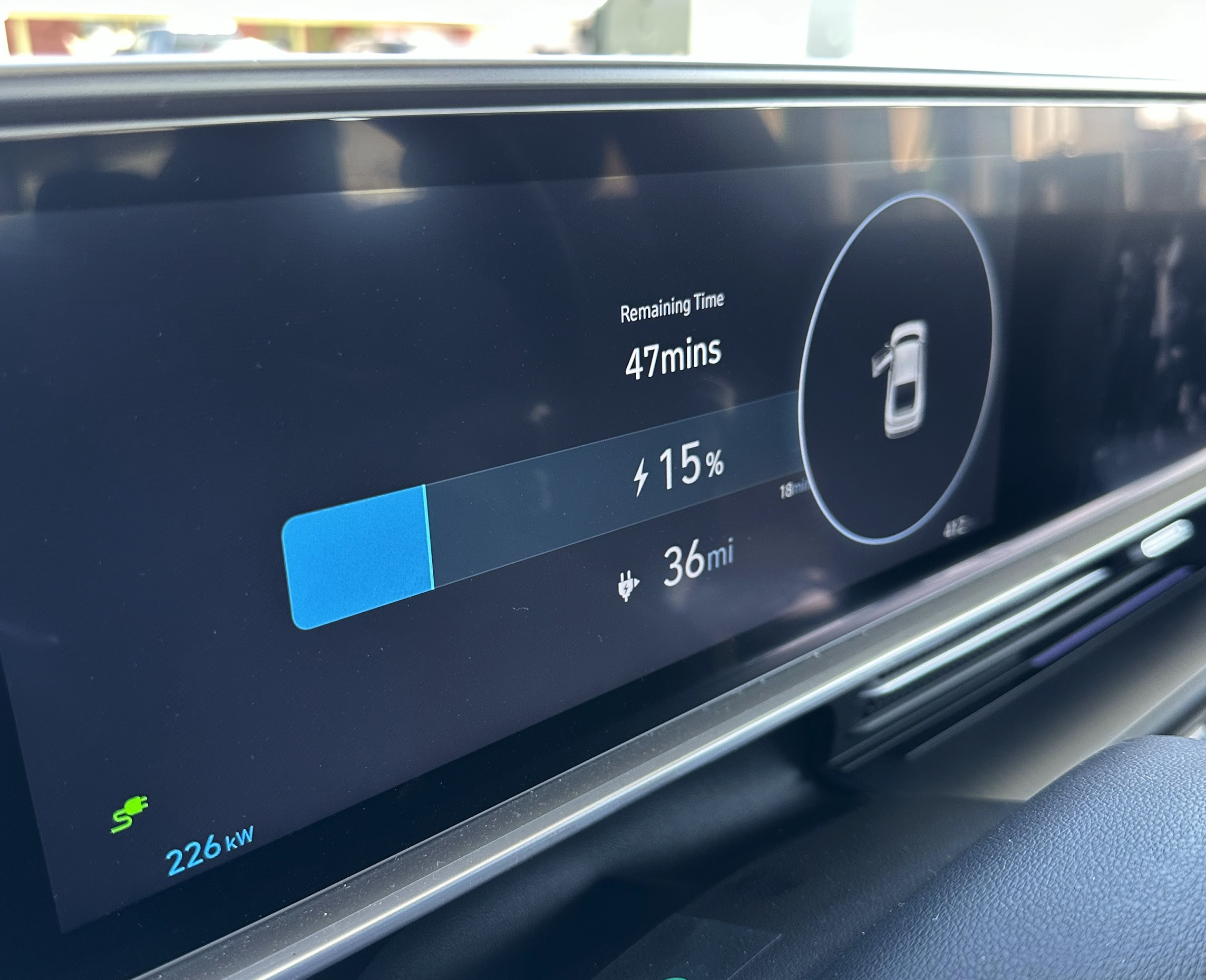Who can resist a good deal? Certainly not me, and so that’s why when NorCal Hyundai dealerships were offering insane lease deals for an Ioniq 6 SEL, I ended up jumping at it. In a whirlwind three days, I negotiated and picked up the lease and sold my old Bolt EUV.

There’s a lot I could say about the new car, and in general I like it a lot. It’s sleek, looks nice, has some weird, annoying quirks, but most importantly it’s a modern drivetrain and battery setup. And the biggest thing is the charge speed. It cannot be overstated how antiquated and frankly useless the Bolt family’s fast charging is. At 55 kW max, it’s painfully slow even in the best conditions, and would frequently average even less than that. If you read my old posts, you’d know that charging on a short road trip could easily be 20% or more of the total time, with hour stops just to drive another hour being common.
So when the opportunity to do another SF to LA road trip popped up, I expected this new car to be smoother. It claims to get 300 miles of range (vs the Bolt’s 240) and it charges five times faster than the Bolt at 250 kW. What I didn’t expect is that not only would it be smoother, but it would also completely change the experience of the road trip itself. Let’s look a little deeper at what went down.
Road Tripping in the Bolt
Before we get into what it’s like to road-trip in the Ioniq 6, let’s look back at what it was like in the Bolt. I’ve actually done three trips from SF to SoCal in the Bolt – the two I blogged about and another one to Santa Barbara that I didn’t bother documenting. The overarching theme in those trips was the planning involved. I’m not sure if it comes across in the blog posts, but it was a serious part of the trip.
Now, on one hand, I’m one of those freaks who actually enjoys logistical planning. Aside from being an EV driver, I’m also a private pilot, and as you’d expect, there’s a significant planning component in any trip going farther than a couple dozen miles. Eyeballing your fuel usage and realizing you need gas RIGHT NOW is a lot scarier when the consequence of not making it to a station isn’t having to push the car but exploding in a fiery wreck (I know, I know if you have no fuel, how will there be fire, bear with me here).
So I really didn’t mind the logistics overhead I had to embark on to drive the Bolt 350 miles. I’d plan out my route, try a bunch of different options, plan out contingencies so I could reroute if I used battery faster than expected, and just generally have an overall picture of exactly how the trip would pan out. It was fun, in a way. Unfortunately, this insane planning and the fact that each stop took upwards of an hour meant nobody ever wanted to drive with me.
The Game Has Changed
Initially, I planned out this trip like I had all the others. The inputs were different, but still the same idea as before:
- Range had increased about 50 miles from the Bolt, which was a nice little bump to the time I could drive between stops.
- Charge speed had quintupled from 50 kW to 250 kW, which made a massive difference in stop times.
- Charger availability had increased quite a bit, especially with the addition of the Tesla network for Hyundai vehicles.
I meticulously planned out the trip the night before, including which chargers I’d stop at and how long. And I stuck to the plan for a single stop. Turns out charging is way easier when it takes one-fifth the time.

When I originally planned out the trip, abetterrouteplanner.com said I should expect to charge for 22 minutes at an EA charger and I’d be good to go. However, once I was actually on the road, my charge usage didn’t pan out exactly as planned. Mostly that was because, on a random weekday, the 5 was pretty empty and traffic was moving at about 80 mph+ the entire way. As anyone else with an EV knows, going 85 instead of 75 makes a big difference in drag and thus range. However, in terms of actual time spent on the road, you’re better off going faster because the car adds range much faster than you can drive. When I reached my planned stop, the route planner said I should expect 18% remaining and instead I was at 11%.
This presented a concern, because I was planning to arrive in LA with 20% remaining battery. If that number was actually more like 10%, then doing the climb over the Grapevine Pass could easily drop me into dangerous territory before the regen kicked in on the way down. So I did what I’d never do in the Bolt. I said “fuck it” and did it live.
My new plan was simple – drive until the car seemed low on charge and then just charge for a while as close as possible to the Grapevine Pass without going over it. I disconnected with 80% battery (which took an astounding 18 minutes to charge to) and just booked it down the freeway to a charging station that seemed promising. Once I arrived, I checked how much farther my destination was and charged until the range estimate was a good amount more than the estimated remaining distance. I felt especially comfortable doing this because (1) waiting until I had plenty of buffer was only maybe 5 more minutes and (2) there was a charging stop near the top of the pass itself. If I got to the top and realized I wasn’t going to make it, I could stop again and top off.
Sure enough, I made it to LA with plenty of charge to spare. Nearly 35% once I arrived.
The New Normal
By far the biggest thing I realized on this trip was that the combination of fast charging and improved infrastructure meant that road tripping with an EV had basically become the same as in a gas car. Sure, it’s not quite as easy, but consider this:
1. The amount of planning is now minimal
On the way home, I abandoned any attempt to plan my trip. I simply found a station that looked like I’d be at about 20% charge when I arrived, and then drove until I was there. I got a coffee and continued until I needed a refill, and stopped again for a charge and coffee at the next charger I came to. Finally, I stopped one final time just for the bathroom because of all the aforementioned coffee, and snagged a little more charge just cause I could.
2. There are way more chargers
Access to the Tesla network opens up a whole world of secondary charging options. I still aimed for Electrify America (EA) stations because I have their subscription and they have 350 kW stations that max out my car, but Tesla does a respectable 150 kW (I tested it before I left) and more importantly has a vast network. Not just in terms of how many stations, but also how many stalls are at each one. The EA network is bigger than before but it’s still maybe 10 stalls max to Tesla’s 80+ at some locations. Unless you’re going on a holiday weekend, it’d be unlikely you have to wait to charge.
3. This trip took just as long as a gas car
Each direction of this trip took about 6.5 hours. Without any stops, I’d guess it would be about 45 minutes faster. At most. Traffic is brutal in both cities, so unless you leave at 5am you’re not doing the 5.5 hours promised by Google Maps. I stopped once for lunch, and then one more time for a quick bathroom break and drink refresh. Even the lunch stops were fast, I’d say it felt about as fast as I’d eat during any normal road trip. It was probably 25 minutes from exiting the freeway to getting back on. I know some people are true hardos who want to just drive and eat in the car, but that’s not me and so as far as I’m concerned, I’m at time parity with my ICE car.
And before the internet “well ackchtually”s me to oblivion, I’m aware that:
- This is a specific, well-traveled route with lots of infrastructure
- This is in fair weather and it wasn’t cold
- This isn’t that long a road trip
I seriously do think that we’re fairly close to closing the road-trip gap for most people. With new technologies, there is always a shrinking list of things that the old thing did better. And yes, long trips, towing, cold weather – these are things that are still difficult for today’s EVs. But with this trip I think most of my road-trip needs are satisfied.
Trip Details
Like the last blog posts, I’ll outline here the actual details of the trip so that others thinking of doing something similar have a benchmark from the real world.
SF to LA
Average Temp: 83 F
Distance: 379 miles
Total time: 6:31
Departure: Friday, 8am
Average efficiency: 2.9 mi/kWh
Charging details
| Date | Location | Charging Time | Total Energy Delivered | Charging Price (pre-tax) | Total Paid | Start State of Charge | End State of Charge |
|---|---|---|---|---|---|---|---|
| 09/05/2025 | Kettleman City | 00:18:20 | 52.1687 kWh | $0.42/kWh | $21.88 | 14% | 78% |
| 09/05/2025 | Bakersfield | 00:13:00 | 29.9000 kWh | $0.48/kWh | $14.35 | 49% | 84% |
LA to SF
Average Temp: 78 F
Distance: 379 miles
Total time: 6:23
Departure: Monday, 7am
Average efficiency: 2.7 mi/kWh
Charging details
| Date | Location | Charging Time | Total Energy Delivered | Charging Price (pre-tax) | Total Paid | Start State of Charge | End State of Charge |
|---|---|---|---|---|---|---|---|
| 09/08/2025 | Kettleman City | 00:19:48 | 58.1758 kWh | $0.42/kWh | $24.40 | 14% | 85% |
| 09/08/2025 | Firebaugh | 00:09:36 | 19.0242 kWh | $0.42/kWh | $7.98 | 58% | 80% |
| 09/08/2025 | Livermore | 00:06:23 | 23.2000 kWh | $0.48/kWh | $11.13 | 27% | 54% |
Until the next one!
- N